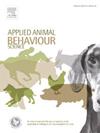Learning and cognitive flexibility in two-choice visual discrimination tasks are similar in juvenile and adult sheep
IF 2
2区 农林科学
Q1 AGRICULTURE, DAIRY & ANIMAL SCIENCE
引用次数: 0
Abstract
The sheep is a valuable species for studying neurodevelopment. The two-choice visual discrimination-reversal task is a widely used set-shifting task assessing function of fronto-striatal brain networks but whether lambs can complete this task has not yet been evaluated. Here we compared cognitive performance in mature adult Texel ewes (n = 12, 1.4–6.4 years old at start of training) and their weaned Texel lambs (n = 5 females, n = 8 non-castrated males, 4.1–5.5 months old) during training and testing in visual attention and two-choice discrimination-reversal tasks within a semi-automated operant system. Adult ewes completed the visual attention task in fewer sessions than lambs (p = 0.030) and a greater proportion of ewes than lambs completed the visual attention task within 10 training sessions (ewes: 8/12; lambs: 3/13; p = 0.028). Numbers of trials taken to reach the learning criterion in the two-choice visual discrimination-reversal task, however, did not differ between adult ewes and lambs during the first acquisition (p = 0.494), or the first (p = 0.955) or second reversal (p = 0.314) phases. Adult ewes completed the second acquisition phase in fewer trials than lambs (p = 0.031). This study confirms that learning and cognitive flexibility can be evaluated using a two-choice visual discrimination-reversal task in growing lambs as well as adult ewes, but that visual attention may take longer to achieve in lambs. This allows longitudinal assessment of the impacts of pregnancy exposures and responses to interventions in sheep models.
幼羊和成年羊在双选择视觉辨别任务中的学习和认知灵活性相似
绵羊是研究神经发育的宝贵物种。双选项视觉判别-反转任务是一种被广泛应用的集移任务,评估额纹状体脑网络的功能,但羔羊是否能完成该任务尚未得到评估。在半自动化操作系统中,我们比较了成熟的成年Texel母羊(n = 12,训练开始时1.4-6.4 岁)和断奶的Texel羔羊(n = 5只雌性,n = 8只未阉割的雄性,4.1-5.5个月大)在视觉注意和两项选择歧视-逆转任务的训练和测试中的认知表现。成年母羊完成视觉注意任务的次数少于羔羊(p = 0.030),在10次训练中完成视觉注意任务的母羊比例高于羔羊(母羊:8/12;羔羊:3/13; = 0.028页)。然而,在第一次学习阶段(p = 0.494)、第一次学习阶段(p = 0.955)或第二次学习阶段(p = 0.314),成年母羊和羔羊为达到学习标准所进行的试验次数并没有差异。成年母羊完成第二阶段的试验次数少于羔羊(p = 0.031)。这项研究证实,学习和认知灵活性可以通过两种选择的视觉辨别逆转任务来评估,既适用于生长中的羔羊,也适用于成年母羊,但羔羊的视觉注意力可能需要更长的时间来实现。这允许纵向评估妊娠暴露的影响和对绵羊模型干预的反应。
本文章由计算机程序翻译,如有差异,请以英文原文为准。
求助全文
约1分钟内获得全文
求助全文
来源期刊

Applied Animal Behaviour Science
农林科学-行为科学
CiteScore
4.40
自引率
21.70%
发文量
191
审稿时长
18.1 weeks
期刊介绍:
This journal publishes relevant information on the behaviour of domesticated and utilized animals.
Topics covered include:
-Behaviour of farm, zoo and laboratory animals in relation to animal management and welfare
-Behaviour of companion animals in relation to behavioural problems, for example, in relation to the training of dogs for different purposes, in relation to behavioural problems
-Studies of the behaviour of wild animals when these studies are relevant from an applied perspective, for example in relation to wildlife management, pest management or nature conservation
-Methodological studies within relevant fields
The principal subjects are farm, companion and laboratory animals, including, of course, poultry. The journal also deals with the following animal subjects:
-Those involved in any farming system, e.g. deer, rabbits and fur-bearing animals
-Those in ANY form of confinement, e.g. zoos, safari parks and other forms of display
-Feral animals, and any animal species which impinge on farming operations, e.g. as causes of loss or damage
-Species used for hunting, recreation etc. may also be considered as acceptable subjects in some instances
-Laboratory animals, if the material relates to their behavioural requirements
 求助内容:
求助内容: 应助结果提醒方式:
应助结果提醒方式:


